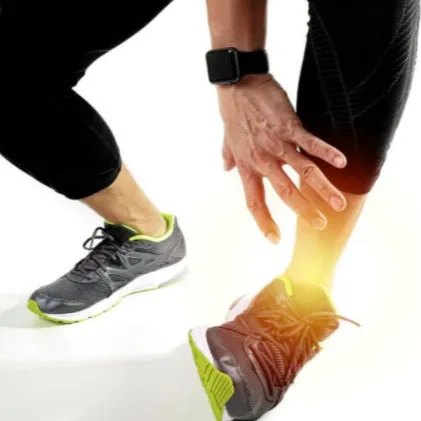@marcbarry1000
A Podiatrist discusses the causes of nail fungus and the various treatment options that are available.
Learn more at https://www.foot-pain-explained.com/nail-fungus.html
Show More Show Less View Video Transcript
0:00
onicomicosis is an infection of the
0:02
nails occurring both on the hands and
0:04
feet but certainly found more on the
0:06
feet due to the environment that feet
0:08
find themselves in this condition
0:11
generally thrives in dark moist
0:13
environments so when you consider
0:15
wearing shoes and socks all day along
0:18
with perspiration that may occur it ends
0:20
up being a perfect growth media for this
0:22
type of
0:23
fungus this condition was rarely seen a
0:26
hundred years ago but has become more
0:28
common due to the lifestyle change that
0:30
we all experience such as communal
0:32
bathing areas greater use of occlusive
0:34
Footwear and the increasing incidence of
0:38
diabetes athletes particularly Runners
0:41
are more inclined to develop this
0:43
problem the incidence of onicomicosis
0:46
increases with age the majority being
0:48
over age 55 but we also see it in
0:51
teenagers as well for most people this
0:54
is a progressive disease that if left
0:56
untreated will continue to spread from
0:58
Toe to Toe symptoms of
1:01
onicomicosis the true tough to get rid
1:04
of fungus actually grows underneath the
1:06
nail as it grows it forces the nail up
1:09
off the nail bed and the nail becomes
1:11
thick crumbly and discolored ranging in
1:14
color from yellow to Brown there may
1:17
also be an odor it is not uncommon for
1:20
these infected Nails spread to the other
1:22
healthy nails it is also not uncommon
1:25
for these types of nails to fall off but
1:28
unfortunately in most cases they grow
1:30
back with nail fungus if not properly
1:32
treated so what is wrong with having
1:35
nail
1:36
fungus one it's cosmetically
1:39
unappealing most people are embarrassed
1:41
by the nail appearance Two nail fungus
1:45
makes you more susceptible to developing
1:47
athletes foot three it increases the
1:50
chance of developing secondary bacterial
1:52
infections in your feet four because of
1:56
the thickness it can cause pain in
1:57
closed shoes it feels like rocks growing
2:00
out of the tops of your
2:01
toes five increases the chances of
2:05
developing developing painful ingrown
2:08
Nails six the sheer Distortion of the
2:10
nails tends to irritate the healthy skin
2:13
on the adjacent toes causing abrasions
2:15
that can become
2:17
infected lastly it is particularly
2:19
dangerous in people who suffer from
2:21
diabetes or circulatory
2:23
problems so what are some of the nail
2:25
fungus
2:26
treatments there is no shortage of nail
2:29
fungus cures on the internet products
2:31
sold in drug stores and in general
2:33
dissemination of incorrect
2:35
information treatment can be difficult
2:38
because of the fact that nail fungus
2:39
thrives in dark moist environments and
2:43
happens to grow underneath the nail
2:45
wearing closed shoes and socks all day
2:48
with feet that perspire creates a
2:49
perfect breeding ground for nail
2:52
fungus eliminating those factors can go
2:54
a long way to reducing
2:56
recurrence nail fungus medications
2:59
include both oral and topical
3:01
treatments as far as oral medications go
3:04
for years the gold standard for treating
3:07
onicomicosis in an otherwise healthy
3:09
individual has been oral therapy the
3:12
most widely prescribed medication today
3:14
is Lamisil tablets although there are
3:16
certainly other antifungals that can be
3:19
used the newer generation of oral
3:21
antifungals are reasonably safe
3:23
medications if properly used Lamisil has
3:27
an adverse response rate of less than 3%
3:31
typically the dosing for Lamisil is one
3:33
tablet per day for 3 months for fungus
3:36
nails prior to taking the medication
3:38
blood work is required to check for
3:40
liver function and renal
3:42
function halfway through the 3-month
3:45
treatment for lamil at approximately 6
3:47
weeks a second blood test is required to
3:50
see if there's any changes in the liver
3:52
enzymes or renal function if there is
3:55
the medication has to be stopped there
3:58
is also a different type of dosing
4:00
schedule for Lamisil known as pulse
4:02
dosing which has become popular instead
4:05
of 90 days worth of Lamisil the post
4:07
dosing is as follows one pill a day for
4:10
7 days then no medication for the next 3
4:13
weeks then one pill per day for a week
4:16
and no medication for 3 weeks then one
4:18
pill per day for 7 days as you can see
4:22
you end up taking 21 pills instead of 90
4:25
pills and the end results can be very
4:28
similar prior to starting on oral
4:31
medication your doctor will need to take
4:33
a sampling of the nail and have it
4:34
tested to confirm if it is true nail
4:37
fungus visual inspection alone is not
4:40
enough many times a thickened nail is
4:43
nothing more than keratinization of the
4:45
underlying nail bed which is a
4:47
thickening of the skin underneath
4:49
usually from repeated
4:50
trauma additionally appearances of
4:53
possible nail fungus can be a result of
4:55
mold or Spore infestation and have
4:57
nothing to do with actual nail fungus
5:00
in those cases oral Lamisil would be
5:03
worthless the other medication option
5:06
for nail fungus is topical
5:08
medication although readily available
5:10
they tend to be less effective the main
5:13
problem is that fungus grows underneath
5:15
the nail so applying medication to the
5:18
top of the nail becomes an effort in
5:20
futility in many cases people trying to
5:23
force the medication underneath the nail
5:25
find that that does not improve the
5:27
outcome at all the best way to use
5:30
topical medication is to see a foot
5:32
specialist who will grind down and cut
5:34
away as much of the disease nail as
5:36
possible which is generally a painless
5:38
procedure so that the topical medication
5:41
will penetrate to the live fungus more
5:43
readily this does become a tedious
5:45
process as the medication generally has
5:48
to be applied twice a day by the patient
5:50
and the nail has to be ground down on a
5:52
regular
5:53
basis the other problem is that
5:55
depending on the degree of fungus this
5:57
process can take upwards of a year
6:00
the other problem with most commercially
6:02
available topical antifungal medications
6:04
is that they are either of a water or
6:06
alcohol base and neither ingredient
6:08
penetrates nail which is primarily
6:11
protein and fat oil-based topical
6:14
antifungals are much better at
6:15
penetrating the nail to get to the
6:17
actual
6:18
fungus if you do not want to take oral
6:21
medication or are not sure you even have
6:23
true nail fungus then the topical
6:25
medication is a very safe
6:28
alternative keep in mind there can be
6:30
failure using either topical or oral
6:33
medication a precursor to those thick
6:35
yellow nails we have been discussing is
6:37
a situation where you notice white
6:39
specks on your nails many women will
6:42
notice them when they remove nail polish
6:45
this is what is known as superficial
6:47
nail fungus where the fungus is growing
6:49
on top of the nail and without proper
6:51
treatment may borrow through the nail
6:53
and cause thickening and
6:55
discoloration people with this condition
6:57
should treat their fungus immediately as
6:59
it is fairly easy to remedy using a
7:01
combination of sanding the top of the
7:03
nail and then applying topical
7:05
antifungal
7:06
medication the last available option for
7:09
nail fungus is laser treatment laser
7:12
became popular in the United States in
7:14
the early
7:15
2000s unlike either topical or oral
7:18
medication laser destroys all the
7:20
different organisms that are growing
7:22
underneath the nail lasers are a
7:25
painless procedure but it is not covered
7:27
by any insurance
7:29
laser surgery has a much higher success
7:31
rate than the oral or topical
7:33
medications and is a safe form of
7:35
treatment it's important to know with
7:38
laser surgery or any other treatment
7:40
that you undertake the disease nail
7:42
itself does not change in appearance
7:45
initially what happens is the diseased
7:47
nail goes from live fungus to dead
7:49
fungus but the appearance does not
7:51
change over time as the nail grows
7:54
forward and the nail is cut away it is
7:57
eventually replaced from behind with
7:59
Healthy Nail which begins at the growth
8:01
plate and grows forward how do we
8:04
prevent the recurrence of nail
8:06
fungus no matter what kind of treatment
8:08
you end up having done on your nails
8:10
that is only half the battle the other
8:13
half is preventing
8:15
recurrence so once your nails have
8:17
cleared up it is important to do some of
8:19
the following use of an antifungal soap
8:22
such as tea tree oil soap to wash your
8:24
feet because tea tree oil has antifungal
8:27
properties if your feet perspire a lot
8:30
you must use a topical drying agent to
8:32
dry the skin out otherwise you will have
8:35
a dark moist environment in which new
8:37
fungus can Thrive you should avoid using
8:40
nylons which promote
8:42
perspiration allowing shoes that are
8:44
moist inside to dry out before wearing
8:47
again and spraying them with an
8:48
antifungal spray keep your nails cut
8:52
short space between the end of the nail
8:54
and the skin underneath is a focal point
8:56
for new fungal
8:58
infections lastly women who wear toenail
9:01
polish on a regular basis are more prone
9:03
to nail
9:04
fungus this is because the Polish when
9:07
applied traps moisture on the nail and
9:09
thus fungus May begin to grow polish
9:12
should be removed regularly and the
9:14
nails should be routinely inspected
#Skin & Nail Care
#Skin Conditions
#Manicures & Pedicures


